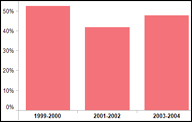
The number of Americans smoking cigarettes may not be changing, but they may be growing more mindful about those around them as they light up.
According to the latest Morbidity and Mortality Weekly Report from the Centers for Disease Control, 20.6 percent adults are current cigarette smokers -- a number that has stayed steady from 2005 to 2009. However, in a separate study published in the same issue of MMWR, researchers found the number of people affected by secondhand smoke significantly declined from 1999 to 2008.
Smoking is leading cause of preventable death in the U.S. and linked to a number of health issues such as heart and lung disease and reproductive complications, according to the CDC. Secondhand smoke in non-smokers is also connected to heart and lung disease, as well as sudden infant death syndrome, respiratory infections, and asthma and middle ear disease in children. Smoking is one of 20 key indicators of health and health care identified by the Institute of Medicine for the State of the USA. (See From Hundreds of Health Measures, 20 Seen as Key.)
Secondhand Exposure Drops, but Disparities Remain
Using data from the National Health and Nutrition Examination Survey, researchers analyzed the serum cotinine (the primary ingredient in nicotine) in non-smokers ages 3 and up from 1999 through 2008. Their findings included a 12.4 percent drop in the number of non-smokers exposed to secondhand smoke over the measured time period. Going back even further to 1988-1991, when levels of serum cotinine were measured in Americans age 4 and up, that decline rises to 48 percent, researchers said.
Despite an almost across the board drop when looking at demographics such as race, gender, age and income group (non-Hispanic whites were the exception), some groups still retained a higher rate of secondhand smoke exposure. Those include males, non-Hispanic blacks, people living below the poverty level and kids (children had the greatest exposure inside homes).
As for why the decline in exposure, researchers attribute it to, "decreased smoking prevalence, increases in the number of local and state laws prohibiting smoking in indoor workplaces and public places, increases in voluntary smoking restrictions in workplaces and homes, and changes in public attitudes regarding social acceptability of smoking near nonsmokers and children."
Overall, about 88 million nonsmokers including 32 million children and teenagers are exposed to secondhand smoke in the U.S. Explore the latest data on secondhand smoke exposure and cigarette smoking using the chart below:
Where Is the Secondhand Smoke Coming From?
In the separate smoking report on the number of current cigarette smokers in the U.S. -- using different data sources and also published in the MMWR -- researchers broke down smokers by demographic, including income level, race, gender, state/region and educational attainment. Data were from the National Health Interview Survey and the Behavioral Risk Factor Surveillance System.
Men, people reporting multiple races, those living below the federal poverty level, people with less than a high school diploma, and those living in the South and Midwest had some of the highest smoking rates. Going by state, Kentucky and West Virginia had the highest rates at 25.6 percent of their populations.
(Nonsmokers' Exposure to Secondhand Smoke - United States, 1999-2008, Current Cigarette Smoking Among Adults Aged ≥18 Years - United States, 2009)
Suzette Lohmeyer is a staff writer and producer for State of the USA.
Data visualization by Anthony Calabrese, a State of the USA Web producer.